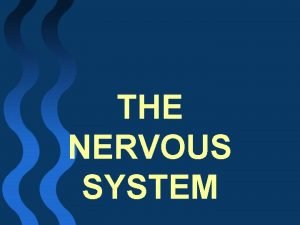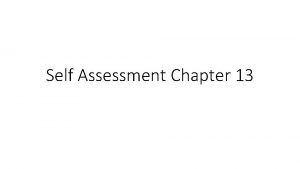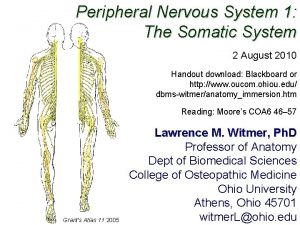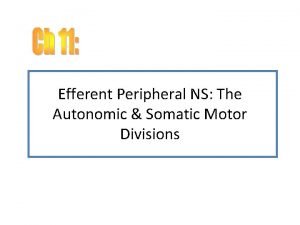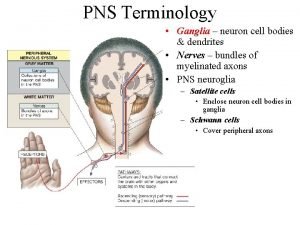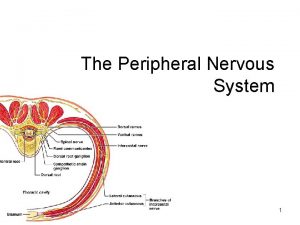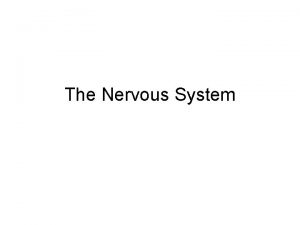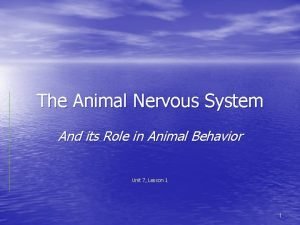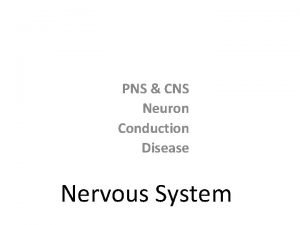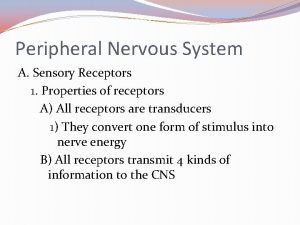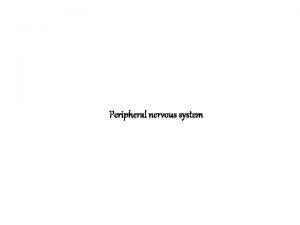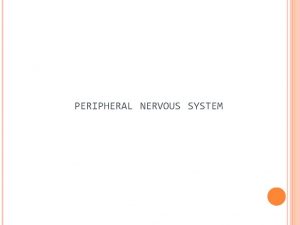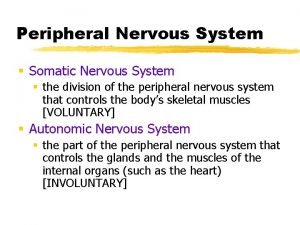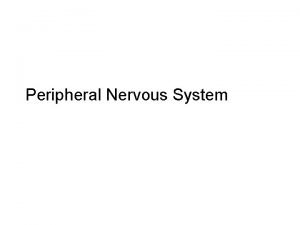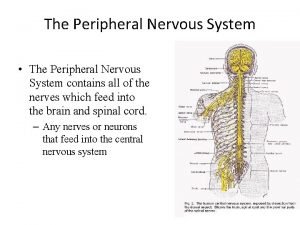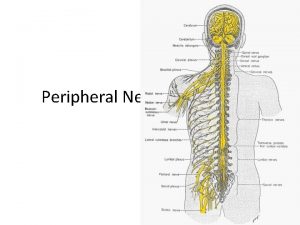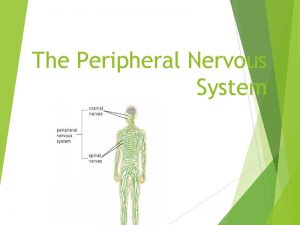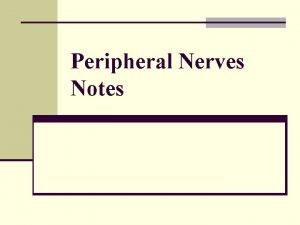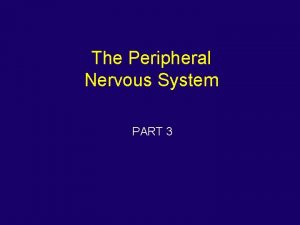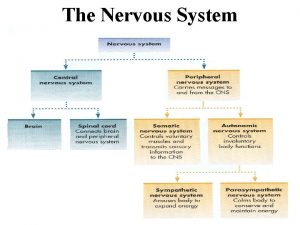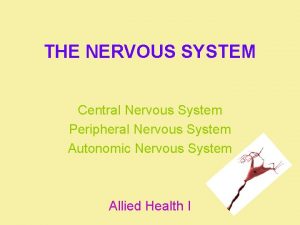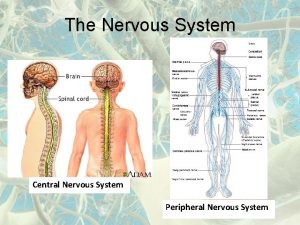Peripheral Nervous System Somatic Nervous System the division




![The Brainstem § Medulla [muh-DUL-uh] § base of the brainstem § controls heartbeat and The Brainstem § Medulla [muh-DUL-uh] § base of the brainstem § controls heartbeat and](https://slidetodoc.com/presentation_image_h2/45673260c4d02662bf2079edaa65647c/image-5.jpg)

![The Brainstem § Cerebellum [sehr-uh. BELL-um] § the “little brain” attached to the rear The Brainstem § Cerebellum [sehr-uh. BELL-um] § the “little brain” attached to the rear](https://slidetodoc.com/presentation_image_h2/45673260c4d02662bf2079edaa65647c/image-7.jpg)


![The Limbic System § Amygdala [ah-MIG-dah-la] § two almond-shaped neural clusters that are components The Limbic System § Amygdala [ah-MIG-dah-la] § two almond-shaped neural clusters that are components](https://slidetodoc.com/presentation_image_h2/45673260c4d02662bf2079edaa65647c/image-10.jpg)










- Slides: 20

Peripheral Nervous System § Somatic Nervous System § the division of the peripheral nervous system that controls the body’s skeletal muscles [VOLUNTARY] § Autonomic Nervous System § the part of the peripheral nervous system that controls the glands and the muscles of the internal organs (such as the heart) [INVOLUNTARY]

Autonomic Nervous System § Sympathetic Nervous System § division of the autonomic nervous system that AROUSES the body, mobilizing its energy in stressful situations § Parasympathetic Nervous System § division of the autonomic nervous system that CALMS the body, conserving its energy

Sympathetic and Parasympathetic

The Brainstem • the oldest part and central core of the brain, beginning where the spinal cord swells as it enters the skull • responsible for automatic survival functions
![The Brainstem Medulla muhDULuh base of the brainstem controls heartbeat and The Brainstem § Medulla [muh-DUL-uh] § base of the brainstem § controls heartbeat and](https://slidetodoc.com/presentation_image_h2/45673260c4d02662bf2079edaa65647c/image-5.jpg)
The Brainstem § Medulla [muh-DUL-uh] § base of the brainstem § controls heartbeat and breathing § Pons § Connects different brain regions together § Involved in facial expressions

The Brainstem § Reticular Formation § a nerve network in the brainstem that plays an important role in controlling arousal § Thalamus [THAL-uh-muss] § the brain’s sensory switchboard, located on top of the brainstem § it directs messages to the sensory receiving areas in the cortex and transmits replies to the cerebellum and medulla
![The Brainstem Cerebellum sehruh BELLum the little brain attached to the rear The Brainstem § Cerebellum [sehr-uh. BELL-um] § the “little brain” attached to the rear](https://slidetodoc.com/presentation_image_h2/45673260c4d02662bf2079edaa65647c/image-7.jpg)
The Brainstem § Cerebellum [sehr-uh. BELL-um] § the “little brain” attached to the rear of the brainstem § it helps coordinate voluntary movement and balance § Formulates implicit memories

The Limbic System • a doughnut-shaped system of neural structures at the border of the brainstem and cerebral hemispheres • associated with emotions such as fear and aggression and drives such as those for food and sex • includes the hippocampus, amygdala, and hypothalamus.

The Limbic System
![The Limbic System Amygdala ahMIGdahla two almondshaped neural clusters that are components The Limbic System § Amygdala [ah-MIG-dah-la] § two almond-shaped neural clusters that are components](https://slidetodoc.com/presentation_image_h2/45673260c4d02662bf2079edaa65647c/image-10.jpg)
The Limbic System § Amygdala [ah-MIG-dah-la] § two almond-shaped neural clusters that are components of the limbic system and are linked to emotion (specifically aggression and fear)

The Limbic System § Hypothalamus § neural structure lying below (hypo) the thalamus; directs several maintenance activities § Eating and drinking § Sex drive § body temperature § helps govern the endocrine system via the pituitary gland

Hypothalamus Stimulation § Electrode implanted in reward center of hypothalamus § Rat readily crosses to get stimulation

The Limbic System z. Hippocampus: a structure in the limbic system linked to explicit memory (Clive Wearing example) z. Pituitary Gland: master endocrine gland, linked to growth (Andre the Giant example)

The Cerebral Cortex Laid out it would be about the size of a large pizza. Cerebral Cortex the intricate fabric of interconnected neural cells that covers the cerebral hemispheres

The Cerebral Cortex § Frontal Lobes § involved in speaking and muscle movements and in making plans and judgments (Phineas Gage Clip) § Parietal Lobes § Involved in sensations (touch), pressure, and pain

The Cerebral Cortex § Occipital Lobes § include the visual areas, which receive visual information from the opposite visual field § Temporal Lobes § include the auditory areas

The Cerebral Cortex § Motor Cortex § area at the rear of the frontal lobes that controls voluntary movements § Sensory Cortex § area at the front of the parietal lobes that registers and processes body sensations

The Cerebral Cortex

The Cerebral Cortex § Functional MRI scan shows the visual cortex activated as the subject looks at faces

Association Areas § “Uncommitted” areas that are not involved in primary functions but play a role in learning, remembering, and thinking § More intelligent animals have increased “uncommitted” or association areas of the cortex
 Somatic nervous system (sns)
Somatic nervous system (sns) Somatic nervous system
Somatic nervous system Somatic nervous system neurotransmitters
Somatic nervous system neurotransmitters Visceral nervous system
Visceral nervous system Nerves
Nerves Somatic nervous system
Somatic nervous system Brain and spinal cord nervous system
Brain and spinal cord nervous system Major division of nervous system
Major division of nervous system Ans
Ans Somatic motor division
Somatic motor division Medunerve
Medunerve Major divisions
Major divisions Peripheral nervous system
Peripheral nervous system Peripheral nervous system
Peripheral nervous system Arthropod nervous system
Arthropod nervous system Peripheral nervous system consists of
Peripheral nervous system consists of Peripheral nervous system consists of
Peripheral nervous system consists of Involuntary movements
Involuntary movements Peripheral nervous system
Peripheral nervous system Pns
Pns Peripheral nervous system
Peripheral nervous system

